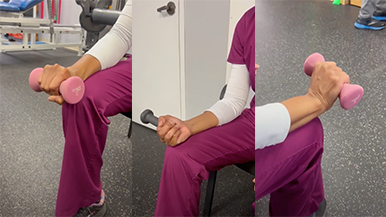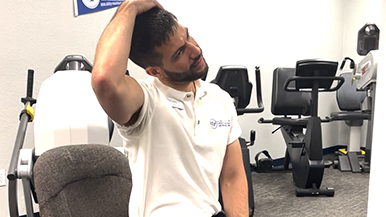Cubital Tunnel Syndrome

Causes of Cubital Tunnel Syndrome
Issues with the ulnar nerve can be the result of several things. Some of the most common causes of ulnar nerve discomfort include:
- Pressure – The ulnar nerve has little padding compared to other nerves in the body. Applying direct pressure on the nerve, like using an armrest or laying on the arm, can cause the arm to fall asleep or generate a “tingling feeling”.
- Stretching – Keeping your elbow bent at an angle can cause the nerve to stretch behind the elbow. This commonly happens during sleep.
- Anatomy – The ulnar nerve doesn’t always stay in place on the elbow and can move back and forth across the elbow. This back and forth movement can cause irritation of the nerve and sometimes create extra tissue on top of the nerve which can keep it from working correctly.
Symptoms of Cubital Tunnel Syndrome
Cubital tunnel syndrome can cause pain, loss of feeling, tingling and/or loss of strength in hands.
Early symptoms include:
- Pain and numbness in the elbow
- Tingling, especially in the ring and little fingers
More severe symptoms include:
- Weakness affecting the ring and little fingers
- Decreased ability to pinch the thumb and little finger
- Decreased overall hand grip
- Muscle wasting in the hand
- Claw-like deformity of the hand
Nonsurgical Treatments for Cubital Tunnel Syndrome
The main and easiest treatment is to avoid or limit any actions that cause symptoms. You can use a blanket or a pillow at night wrapped around your arm to keep it from bending while you sleep. If symptoms do not stop, there are several conservative treatment methods your physical therapist or physician may make before attempting surgery.
- Physical Therapy – Range-of-motion exercises help to restore the full length of the muscles to that have shortened due to protective posturing.
- Medication – Medications, such as ibuprofen, can help reduce pain and inflammation of the affected area. Prescription medication may also help if discomfort continues.
- Activity Modification – You should refrain from movements and postures that cause discomfort. Taking frequent breaks to rest when performing such movements, will help to minimize irritation of the nerve.
Surgical Treatments for Cubital Tunnel Syndrome
When all conservative measures listed above have failed, surgery made needed to correct the nerve and relieve pressure on the elbow. There are a few surgical procedures that will relieve pressure on the ulnar nerve at the elbow. Your hand specialist will talk with you about the option that would be best for you and refer you to a hand surgeon. Common surgical procedures performed are:
- Cubital Tunnel Release – The ligament of the cubital tunnel is cut and divided. This increases the size of the tunnel, thus decreasing pressure on the nerve.
- Ulnar Nerve Anterior Transposition – The nerve is moved from its place behind the medial epicondyle to a new position in front of it. The nerve can be moved to lie under the skin and fat but on top, within or under the muscle.
- Medial Epicondylectomy – Like ulnar nerve transposition, this technique also prevents the nerve from getting caught on the boney ridge and stretching when your elbow is bent.



